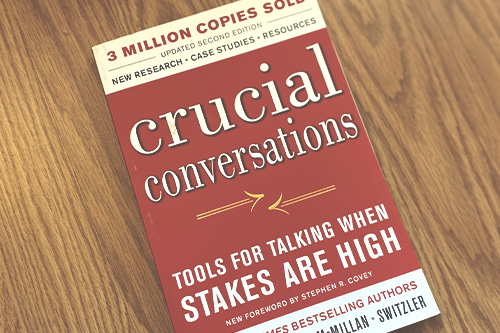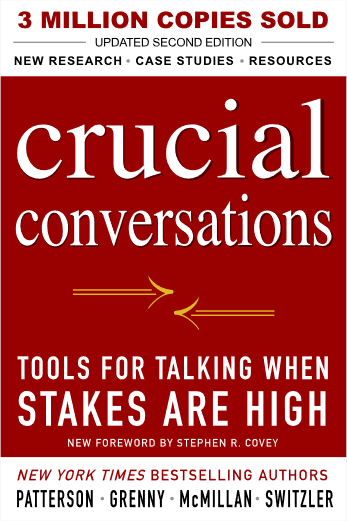

An element of everyday human activity that can be changed forever in the future, for better or for worse.

These repetitive daily activities affect everyone's lives in a variety of situations, and the outcome of these pivotal conversations is incredibly important. That's not a concept the book's authors meant They care about the interactions that happen to everyone.ĭecisive talks are defined as discussions between two people where there is significance, opinions are divergent, and emotions are strongly expressed. And Crucial Conversations gave me many additional skills and thought-prompts to do this.The phrase “decisive talk” conjures up images of great figures and statesmen engaging in meetings and discussions whose outcome will have an impact on the world.

I would prefer to be in dialogue rather than playing games, doing good work rather than navigating superficially. In thinking about current conversations, they suggest asking “Are we playing games or are we in dialogue?” as a place to start, to see if a crucial conversation is happening or needed.Īs someone who wants to do excellent work, at a deeper level than office politics sometimes allows employees to do, this question summed up my experience of Crucial Conversations. Toward the end of the book, the authors ask a question I found both funny and incredibly encouraging. This is a great technique for those of us who tend to take problems personally or get too involved. In Asking, Mirroring, Paraphrasing, and Priming, one can get an accurate view of the situation while even keeping it at arm’s length. Haven’t we all seen leaders ask for feedback or questions, only to be met by silence or agreement? A lot of the advice in Crucial Conversations will be useful to leaders wanting actual responses, innovative ideas, questions, and even challenges to what they’re saying.įor those who are hesitant to open the (imagined) flood gates of challenging conversations, there’s even a process with an acronym the authors propose: AMPP. With an open mind, your own stance might be changed with this new info! Or, even better, a deeper level of the project/problem might be found.Īnother great aspect of the book is its potential use for developing a more open leadership style. For example, saying “I was wondering why…” is one way to dive deeper into a colleague’s stance or opinion. The book is also practical in giving readers specific ways to speak or engage in dialogue when a crucial conversation is identified as such. Crucial conversations are a competitive advantage.Ĭrucial Conversations helps readers identify opportunities for these kinds of interactions before they may even need to happen, which if internalized would contribute to employee EQ and improve company-wide meetings, processes, or results. And, most impressive, a study that found organizations that held crucial conversations was five times faster in responding to financial downturns.
Crucial conversations book study full#
They cite a study in which $1,500 and a full workday were saved for every crucial conversation employees held rather than avoided, a substantial amount given the nonprofit clients I tend to work with. I appreciate the business case the authors make for having healthy crucial conversations. They’re the conversations about a promotion or raise and about whether your ten year old needs a smartphone.
Crucial conversations book study professional#
These are the conversations every person has (or, conversely: avoids) in both personal and professional settings. The authors, Karry Patterson, Joseph Grenny, Ron McMillan, and Al Switzler, define a crucial conversation as one in which opinions vary, stakes are high, and emotions run strong. It’s a physically small book that packed a large punch and I’m even considering giving it a second read.

Crucial Conversations: Tools for Talking when Stakes are High caught my eye as I was starting a new project that I knew would require an elevated level of listening, conflict resolution, and verbal skill.


 0 kommentar(er)
0 kommentar(er)
